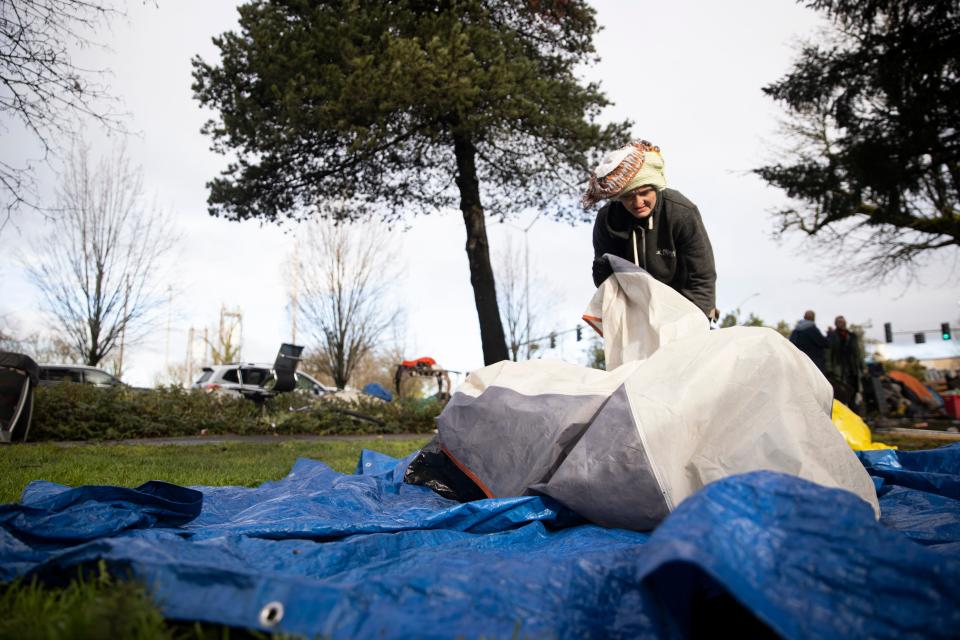Annual count indicates spike in Mid-Valley homelessness

The number of people experiencing homelessness in the Marion-Polk region is growing, at least according to Mid-Willamette Valley Homeless Alliance's 2022 Point-In-Time count.
But the reasons behind the 15% increase compared to last year’s count aren't as clear cut, the alliance said.
The U.S. Department of Housing and Urban Development requires regions to conduct a census of people who are unsheltered in order to remain eligible for funding for housing and homelessness services. This year, volunteers, shelter staff and outreach workers conducted the survey on Jan. 25, Jan. 26 and Jan. 29 and connected with 1,805 people.
The count gathered information about where they slept on the night of Jan. 24, their age, gender and veteran status.
Here is what the count found about those 1,805 individuals:
879 were unsheltered and 926 were temporarily unsheltered individuals.
35% were female, 64% were male and 1% were transgender, non-singular, or questioning.
14% were Hispanic.
Those numbers don't reflect broader counts that indicate the Mid-Valley has more homeless women than men, contradicting trends nationwide. According to the Marion and Polk Coordinated Entry data from 2021, which surveys people trying to get housing and other services, there were 1,318 adult homeless women, compared to 1,239 men.
People counted in the Point in Time count were also asked whether the COVID-19 pandemic or wildfires caused their unsheltered status but analysis of that data is ongoing, said Robert Marshall, ARCHES program manager and co-chair of the Alliance's 2022 PIT Count Workgroup.
"This count provides a stage for those experiencing homelessness to share their stories and for volunteers and community members to witness the raw effects that being homeless has on a person. It's the stories of lived experience that allow us to make informed decisions about our service provisions and keep the flame burning inside the souls of community members to continue advocating for change," Marshall said in a news release about the results.

There are many reasons the numbers can go up and down, Jan Calvin, consultant for the Mid-Willamette Valley Homeless Alliance, said. The alliance attempted to keep the approach in data collection as consistent as possible between 2021 and 2022 but shifts occur. Things like hours spent in the public, the number of volunteers, and weather can all affect the count.
The increase in number could mean there were more people experiencing homelessness this year during the PIT count but there was also a more robust effort in getting volunteers trained and out into the community, added Marshall.
A lot of work was done beforehand utilizing existing outreach teams to gather information about where volunteers should go. Teams had lists of areas of interest and high-density areas for the days of the PIT count, Marshall said.
"We were able to maximize our efforts and utilize our time and our resources more wisely by using that approach because we essentially did more of a reconnaissance type effort ahead of the Point-in-Time count," he said.
The 'invisible' homeless:Women outnumber men in Oregon’s Mid-Valley, but services lag
In 2021, there was also snow during the PIT count, Calvin added.
"So that's one of the questions. Did that impact numbers? Is that why we're up 15%?" she said.
Calvin warned people not to limit their understanding of the issue to the demographic data. Doing so runs the risk "of only managing homelessness, not ending it," she said. She hopes people don't just stop at looking at the PIT count but also look at the "what to do pieces."
The PIT count and data are just one piece to the bigger story of homelessness, said Marshall. It is also a community engagement tool, allowing volunteers to interact and better connect with individuals experiencing homelessness and an entry point to combine data with advocacy.
"When you start trying to equate humans down to numbers people lose that personal connection," he added. "The numbers only go so far."
This article originally appeared on Salem Statesman Journal: Results of 2022 Point-in-Time Count released

